Transcriptional regulation of mitochondrial glycerophosphate acyltransferase is mediated by distal promoter via ChREBP and SREBP-1
- PMID: 19682972
- PMCID: PMC2761506
- DOI: 10.1016/j.abb.2009.07.027
Transcriptional regulation of mitochondrial glycerophosphate acyltransferase is mediated by distal promoter via ChREBP and SREBP-1
Abstract
We have recently identified two promoters, distal and proximal for rat mitochondrial glycerophosphate acyltransferase (mtGPAT). Here we are reporting further characterization of the promoters. Insulin and epidermal growth factor (EGF) stimulated while leptin and glucagon inhibited the luciferase activity of the distal promoter and the amounts of the distal transcript. Conversely, luciferase activity of the proximal promoter and proximal transcript remained unchanged due to these treatments. Only the distal promoter has binding sites for carbohydrate response element binding protein (ChREBP) and sterol regulatory element binding protein-1 (SREBP-1). Electromobility shift assays and chromatin immunoprecipitation assays demonstrated that ChREBP and SREBP-1 bind to the mtGPAT distal promoter. Insulin and EGF increased while glucagon and leptin decreased the binding of SREBP-1 and ChREBP to the distal promoter. Thus, the distal promoter is the regulatory promoter while the proximal promoter acts constitutively for rat mtGPAT gene under the influence of hormones and growth factor.
Figures

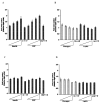
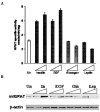
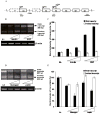
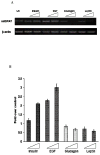

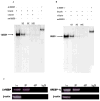

Similar articles
-
Histone modifications in FASN modulated by sterol regulatory element-binding protein 1c and carbohydrate responsive-element binding protein under insulin stimulation are related to NAFLD.Biochem Biophys Res Commun. 2017 Jan 29;483(1):409-417. doi: 10.1016/j.bbrc.2016.12.129. Epub 2016 Dec 24. Biochem Biophys Res Commun. 2017. PMID: 28027934
-
The presence of distal and proximal promoters for rat mitochondrial glycerol-3-phosphate acyltransferase.Arch Biochem Biophys. 2008 Feb 1;470(1):35-43. doi: 10.1016/j.abb.2007.10.019. Epub 2007 Nov 4. Arch Biochem Biophys. 2008. PMID: 18021946 Free PMC article.
-
Distinct regulation of adiponutrin/PNPLA3 gene expression by the transcription factors ChREBP and SREBP1c in mouse and human hepatocytes.J Hepatol. 2011 Jul;55(1):145-53. doi: 10.1016/j.jhep.2010.10.024. Epub 2010 Nov 30. J Hepatol. 2011. PMID: 21145868
-
Atorvastatin prevents carbohydrate response element binding protein activation in the fructose-fed rat by activating protein kinase A.Hepatology. 2009 Jan;49(1):106-15. doi: 10.1002/hep.22570. Hepatology. 2009. PMID: 19053045
-
ChREBP: a glucose-activated transcription factor involved in the development of metabolic syndrome.Endocr J. 2008 Aug;55(4):617-24. doi: 10.1507/endocrj.k07e-110. Epub 2008 May 19. Endocr J. 2008. PMID: 18490833 Review.
Cited by
-
The lipogenic transcription factor ChREBP dissociates hepatic steatosis from insulin resistance in mice and humans.J Clin Invest. 2012 Jun;122(6):2176-94. doi: 10.1172/JCI41636. Epub 2012 May 1. J Clin Invest. 2012. PMID: 22546860 Free PMC article. Clinical Trial.
-
Transcriptional Regulation of Acyl-CoA:Glycerol-sn-3-Phosphate Acyltransferases.Int J Mol Sci. 2019 Feb 22;20(4):964. doi: 10.3390/ijms20040964. Int J Mol Sci. 2019. PMID: 30813330 Free PMC article. Review.
-
Carbon source metabolism and its regulation in cancer cells.Crit Rev Eukaryot Gene Expr. 2012;22(1):17-35. doi: 10.1615/critreveukargeneexpr.v22.i1.20. Crit Rev Eukaryot Gene Expr. 2012. PMID: 22339657 Free PMC article. Review.
-
How lipid droplets "TAG" along: Glycerolipid synthetic enzymes and lipid storage.Biochim Biophys Acta Mol Cell Biol Lipids. 2017 Oct;1862(10 Pt B):1131-1145. doi: 10.1016/j.bbalip.2017.06.010. Epub 2017 Jun 20. Biochim Biophys Acta Mol Cell Biol Lipids. 2017. PMID: 28642195 Free PMC article. Review.
-
The relationship among brain natriuretic peptide (BNP), cholesterol and lipoprotein.Heart Asia. 2012 Jan 1;4(1):11-5. doi: 10.1136/heartasia-2011-010042. eCollection 2012. Heart Asia. 2012. PMID: 27326018 Free PMC article.
References
-
- Haldar D, Kelker HC, Pullman ME. Properties of acyl coenzyme A: 1-acyl-sn-glycerol 3-phosphate acyltransferase from rat liver mitochondria and microsomes. Trans N Y Acad Sci. 1983;41:173–182. - PubMed
-
- Linden D, William-Olsson L, Rhedin M, Asztely AK, Clapham JC, Schreyer S. Overexpression of mitochondrial GPAT in rat hepatocytes leads to decreased fatty acid oxidation and increased glycerolipid biosynthesis. J Lipid Res. 2004;45:1279–1288. - PubMed
-
- Onorato TM, Chakraborty S, Balija VS, Haldar D. In: LIPIDS: Glycerolipid Metabolizing Enzymes. Haldar D, Das SK, editors. Research Signpost; Trivandrum: 2002.
-
- Hammond LE, Gallagher PA, Wang S, Hiller S, Kluckman KD, Posey-Marcos EL, Maeda N, Coleman RA. Mitochondrial glycerol-3-phosphate acyltransferase-deficient mice have reduced weight and liver triacylglycerol content and altered glycerolipid fatty acid composition. Mol Cell Biol. 2002;22:8204–8214. - PMC - PubMed
-
- Lindén D, William-Olsson L, Ahnmark A, Ekroos K, Hallberg C, Sjögren HP, Becker B, Svensson L, Clapham JC, Oscarsson J, Schreyer S. Liver-directed overexpression of mitochondrial glycerol-3-phosphate acyltransferase results in hepatic steatosis, increased triacylglycerol secretion and reduced fatty acid oxidation. FASEB J. 2006;20:434–443. - PubMed
Publication types
MeSH terms
Substances
Grants and funding
LinkOut - more resources
Full Text Sources
Molecular Biology Databases
Research Materials

